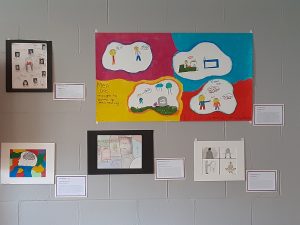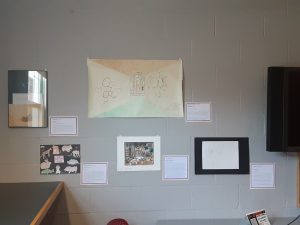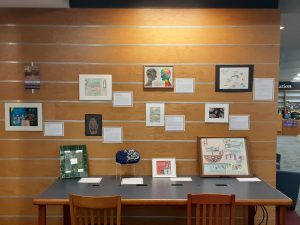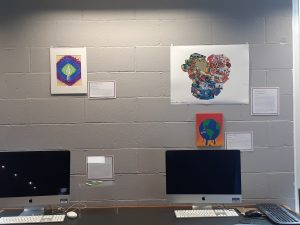2 A Recipe for: Making Space in the Makerspace to Cook up Multimodal Arguments
Kelly L Wheeler
FOR: CCCC 2024
FROM THE KITCHEN OF: Kelly L. Wheeler, Curry College, Milton MA
PREP TIME: 10 weeks
COOK TIME: Five weeks
SERVES: 20 students per class
Exigence
2023 was the 50th Anniversary of The Curry Arts Journal, and Curry was looking to showcase this milestone in a variety of ways: one of which was the creation of public-facing Online Exhibits that showcase the artists and works of The Curry Arts Journal as well as research and art that The Curry Arts Journal has inspired. Students compiled and wrote an extended argument-based research paper inspired by one of the art pieces within a select year’s Journal. Alongside writing and researching, students created some kind of art that utilized the newly created Makerspace within our library to make their paper’s argument.
Ingredients and Steps
The assignments we did in class built to a final paper and multimodal component that were combined into an online public-facing exhibit that was set up in the library for two weeks as part of Curry College’s Curry Creates: A Festival of Arts and Wellness link here. On opening night for the festival, the art projects and computers housing the online exhibits were available for students, staff, and faculty to tour. We had four student docents who talked about the project and process. To facilitate this: I built in check-ins throughout the semester to help students be successful.
- Complete a Close Reading of a Linguistic Text link to assignment
- Complete a Close Reading of a Visual/Multimodal Text link to assignment
- Create a Research Question inspired by a Text from your Journal
- Complete an Interview: Interviewing as a Primary Source link to assignment to help answer your Research Question
- Research a Question and Find an Answer (not to be confused with THE ANSWER)
- Answer Your Research Question through the use of peer-reviewed sources
- Creating an Online Exhibit link to assignment This exhibit will contain:
- An image of your artist’s work
- A summary of your interview of the artist or key question/answers you feel give visitors a glimpse into your artist
- A description of your artist’s piece of art (You may choose to ask the artist for this information; you may pull from The Curry Arts Journal; or you may create your own.)
- Art Creation link to assignment of a piece of art inspired by your original artist
- An image of your own artwork
- A description of your art piece
- Creation of an Artist Statement link to assignment for your art piece
- Your full research paper link to assignment with an explanation of how it connects to your art and the art of your artist. (Link to Research Paper Rubric here)
- Give and Respond to User Experience Feedback
- Present your Exhibit and Art in Levin Library the week of reading period and finals. Your work will be part of an activity that students, staff, and faculty can engage with as part of Curry Creates: A Festival of Arts and Wellness on May 5th.
- Reflecting on the Research Process link to assignment
Images of Multimodal Arguments Created by Students





Recipe Reviews:
One BIPOC student wrote:
“During the start of the research process, we were given the task of finding a piece of art from [T]he 2011 Curry Arts Journal that we believed fit with our topics the best. The art that I had chosen was a poem called “Listen” written by Caitlin Collins. This art selection properly corresponds with my research topic because the main point of the poem was centered around the power of listening to yourself as well as to others. The poem also focuses on the fact that listening allows us to acquire knowledge that we did not originally possess. This falls in line with my topic on America not completely turning away from racism. If people took time to listen and consider the feelings of others th[e]n racism would probably not be an issue in this country or at least it would not be as prominent.”
Male PAL* student:
“For the art portion of this project, I wanted the 3D-printed tennis court on top of a phone to represent the way that sports can be played virtually through technology. Creating that art changed my view of my research in one way. By physically working with a phone, I was reminded that my topic was about real devices that we carry around with us every day. Having to create an “object” showed me that my research was more than just a bunch of ideas put on paper. Those research ideas had a connection with something real in our world.”
Male student athlete:
“My art ties into my research paper because my topic discusses mindfulness based practices. Nature is a good example of a mindfulness based practice that is available for everyone. In the production of my art, I went out for a walk and took pictures of the intricate beauties of nature. The idea of going for a walk to take these pictures is exactly what I was trying to argue in this research paper, that [by] practicing meditation and mindfulness based practices, your stress would reduce and for my paper’s sake, increase sports performance.”
Female student athlete:
“Creating art made me think about my research paper differently because I had a more artistic and creative approach to writing. Making my piece relate to my research paper though art showed that you can express different meanings though more than just words. I enjoyed creating art that was inspired by a poem and related to mental health just like my paper did. This shows that there are so many different ways to bring light to mental health and have the same message come through, whether it’s through art, poems, or a research paper.”
*PAL (Program for Advancement of Learning) Link to PAL website here.

